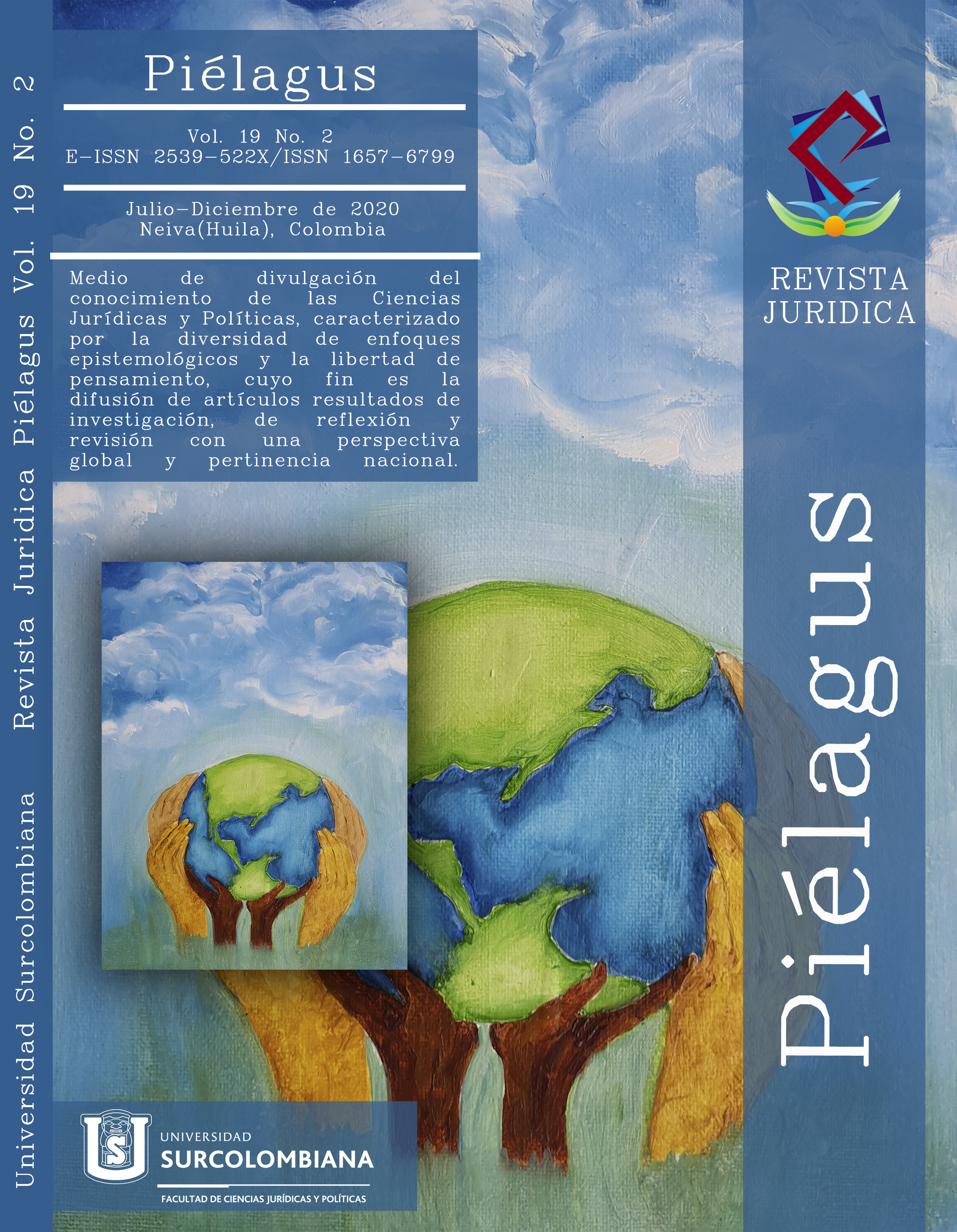Descifrando el fenómeno de los acaparamientos de tierras en el marco de la Unión Europea:
respuestas jurídico-políticas e incidencia de la producción de los biocombustibles
##plugins.themes.bootstrap3.article.main##
Cuando se habla de acaparamientos de tierras, o de problemas en torno a la tierra, realmente no se piensa en que éste sea un fenómeno que se está produciendo también en el interior de la UE, más bien pensamos sobre todo en otras partes del mundo, como en el Sur Global, en Estados Latinoamericanos o en África. No obstante, la realidad es que en Europa hoy en día, la concentración de tierras bajo explotaciones cada vez más grandes controladas por menos manos (como resultado, en parte, del acaparamiento de tierras y de la reducción del acceso a la tierra para los pequeños productores de alimentos), se está acelerando. El objetivo de nuestro trabajo es ofrecer un análisis jurídico, social y político general del fenómeno del acaparamiento de tierras, sobre todo de las tierras agrícolas, dentro de la UE, haciendo una presentación de los principales retos jurídicos y políticos que se plantean ad intra. También nos centraremos en el análisis de ciertas Directivas Europeas que tienen incidencia en la política de la Unión sobre los biocombustibles y por tanto también en los posibles acaparamientos de tierra ad extra que se realicen en el marco de la Unión Europea.
Los temas presentados en este trabajo son complejos y multidisciplinares por lo que se pueden abordar desde diferentes perspectivas, sin embargo, hemos tenido en cuenta, para acortarlo al objeto de estudio, la base de los acaparamientos de tierras en el marco del derecho de la Unión Europea. En este sentido, el método científico que ha sido empleado es el jurídico-sociológico, en la medida en que es el que consideramos más apropiado para el enfoque multidisciplinar. Este método consiste en analizar el estado actual de las normas y la interrelación entre las posibles fuentes jurídicas, pero teniéndose en cuenta los elementos sociales, económicos, políticos e históricos que permiten explicar la eficacia, fundamentación y aplicabilidad de las normas. Para la elaboración de este trabajo también se ha requerido el empleo de técnicas metodológicas muy variadas, como el análisis social y jurídico, la deducción e inducción jurídica, la descripción y la interdisciplinariedad.
Descargas
##plugins.themes.bootstrap3.article.details##
I. Antonelli, M., Siciliano, G., Turvani, M. E., & Rulli, M. C. (2015). Global investments in agricultural land and the role of the EU: Drivers, scope and potential impacts. Land Use Policy, 47, 98-111. doi: 10.1016/j.landusepol.2015.04.007
II. Bartels, L. (2009). Trade and Human Rights. In D. Bethlehem, I. Van Damme, D. Mcrae, & R. Neufeld (Eds.), The Oxford Handbook of International Law. (pp. 571-596). New York, NY: Oxford University Press.
III. Bartels, L. (2014). The European Parliament’s Role in Relation to Human Rights in Trade and Investment Agreements. Retrieved from https://www.europarl.europa.eu/cmsdata/86031/Study.pdf
IV. Bird Life, European Environmental Bureau, FERN, Friends of the Earth Europe, Oxfam International, & Transport and Environment. (2009). Biofuels: Handle with care. An analysis of EU biofuel policy with recommendations for action. Retrieved from https://www.birdlife.org/sites/default/files/attachments/biofuels_handle%20with%20care_final.pdf
V. Borras, S. M. (2016). Land Grabbing and human rights: The involvement of European corporate and financial entities in land grabbing outside the European Union. Retrieved from https://www.europarl.europa.eu/RegData/etudes/STUD/2016/578007/EXPO_STU(2016)578007_EN.pdf
VI. Borras, S. M., Franco, J. C., Gómez, S., Kay, C., & Spoor, M. (2012). Land grabbing in Latin America and the Caribbean. The Journal of Peasant Studies, 39, 209-216. doi: 10.1080/03066150.2012.679931.
VII. Borras, S., Franco, J., & van der Ploeg, J. D. (2013). Land concentration, land grabbing and people’s struggles in Europe: Introduction to the collection of studies. In J. Franco & S. M. Borras (Eds.), Land concentration, Land grabbing and People’s struggles: Take Action against Land grabbing in Europe (pp. 7-28). Retrieved from https://www.tni.org/files/download/land_in_europe-jun2013.pdf
VIII. Borras, S. M., Hall, R., Scoones, I., White., & Wolford, W. (2011). Towards a better understanding of global land grabbing: an editorial introduction. The Journal of Peasant Studies, 38, 845-872 doi: 10.1080/03066150.2011.559005
IX. Bunkus, R., & Theesfeld, I. (2018). Land Grabbing in Europe? Socio-Cultural Externalities of Large-Scale Land Acquisitions in East Germany. Land, 7, 98. doi: 10.3390/land7030098
X. Casadinho, J. S. (2019). El proceso de artificialización de la naturaleza y el desarrollo de la agroecología en la Argentina. Cultura Económica, 36(96), 43-76. Retrieved from http://200.16.86.39/index.php/CECON/index
XI. Committee on World Food Security. “Voluntary guidelines on the responsible governance of tenure of land, fisheries and forests in the context of national food security”. Food and Agriculture Organization of the United Nations, Rome, 2012.
XII. Constantin, C., Luminița, C., & Vasile, A. J. (2017). Land grabbing: A review of extent and possible consequences in Romania. Land Use Policy, 62, 143-150. doi: 10.1016/j.landusepol.2017.01.001
XIII. Cotula, L. (2014). Adressing the Human Rights Impacts of “Land Grabbing”. Retrieved from https://www.europarl.europa.eu/RegData/etudes/STUD/2014/534984/EXPO_STU(2014)534984_EN.pdf
XIV. Cotula, L., Dyer, N., & Vermeulen, S. (2008). Fuelling Exclusion? The Biofuels Boom and Poor People’s Access to Land. London, England: International Institute for Environmental and Development and Food Agriculture Organization of the United Nations.
XV. Eurostat. (2019). Farm Structure Stadistics. Retrieved from https://ec.europa.eu/eurostat/statistics-explained/index.php?title=Farm_structure_statistics/es&oldid=442608
XVI. Fairhead, J., Leach, M., & Scoones, I. (2012). Green Grabbing: a new appropriation of nature? The Journal of Peasant Studies, 39, 237-261. doi:10.1080/03066150.2012.671770
XVII. Franco, J. & Borras, S. M. (2013). Land concentration, Land grabbing and People’s struggles: Take Action against Land grabbing in Europe. Retrieved from https://www.tni.org/files/download/land_in_europe-jun2013.pdf
XVIII. Gonda, N. (2019). Land grabbing and the making of an authoritarian populist regime in Hungary. The Journal of Peasant Studies, 46, 606-625. doi: 10.1080/03066150.2019.1584190
XIX. Graham, A., Aubry, S., Künnemann, R., & Monsalve, S. M. (2011). Land Grab Study. CSO Monitoring 2009-2010 “Advancing African Agriculture” (AAA): The Impact of Europe’s Policies and Practices on African Agriculture and Food Security. Retrieved from https://afrique-europe-interact.net/files/englisch_-_10_fianetal_land_grab_study_europeaninvolvement.pdf
XX. Kay, S. (2018). Acaparamiento y concentración de tierras en Europa, Reseña de Investigación. Amsterdam, Países Bajos: Transnational Institute, Hands on The Land.
XXI. Kay, S., Peuch, J., & Franco, J. (2015). Extent of farmland grabbing in the EU, Policy Department B: Structural and Cohesion Policies. European Parliament. Retrieved from: https://www.europarl.europa.eu/RegData/etudes/STUD/2015/540369/IPOL_STU(2015)540369_EN.pdf
XXII. McMichael, P. (2014). Rethinking land grab ontology, Rural Sociology, 79, 34-55. doi: org/10.1111/ruso.12021
XXIII. Medarov, G. (2013). Land concentration, land grabbing and land conflicts in Europe: The case of Boynitsa in Bulgaria. In J. Franco & S. M. Borras (Coords.), Land concentration, land grabbing and people´s struggles in Europe (pp. 168-193). Retrieved from https://www.tni.org/files/download/land_in_europe-jun2013.pdf
XXIV. Nowak, A. (2013). Es grünt so grün. Green Grabbing und Akkumulation durch Enteignung. In M. Backhouse, O. Gerlach, S. Kalmring, & A. Nowak, Die globale Einhegung – Krise, ursprüngliche Akkumulation und Landnahmen im Kapitalismus (pp. 247–262). Münster, Germany: Westfälisches Dampfboot.
XXV. Petit, Y. (2018). L’Union européenne et le phénomène d’accaparement des terres agricoles. La Documentation française. Retrieved from https://farmlandgrab.org/28043
XXVI. Surman, J. (2014). EU Market Mechanisms - Don't Let the Mice Guard the Cheese. Retrieved from: http://socialismoryourmoneyback.blogspot.com/2014/11/eu-market-mechanisms-dont-let-mice.html
XXVII. Toulmin, C., Bindraban, P., Borras, S. M., Mwangi, E., & Sauer, S. (2011). Tenencia de la tierra e inversiones internacionales en agricultura. Un informe del grupo de expertos de alto nivel sobre seguridad alimentaria y nutrición. Rome, Italy: Committe on World Food Security.
XXVIII. CJEU, (1984). Judgment of the Court of Justice of 6 November 1984. Case 182/83. Paragraph 3. Retrieved from: http://curia.europa.eu/juris/liste.jsf?language=en&num=C-182/83
XXIX. CJEU, (1999). Judgment of the Court of Justice of 1 June 1999. Case C-302/97. Paragraph 38. Retrieved from: http://curia.europa.eu/juris/document/document.jsf?docid=44617&doclang=EN
XXX. CJEU, (2002). Judgment of the Court of Justice of 4 June 2002. Case C-367/98. Paragraph 48. Retrieved from: http://curia.europa.eu/juris/liste.jsf?num=C-367/98
XXXI. CJEU, (2003). Judgment of the Court of Justice of 23 September 2003. Case C-452/01. Paragraphs 24, 39-40. Retrieved from: http://curia.europa.eu/juris/liste.jsf?language=en&num=452/01
XXXII. CJEU, (2007). Judgment of the Court (Third Chamber) of 25 January 2007. Case C-370/05.Paragraphs 27-28. Retrieved from: http://curia.europa.eu/juris/liste.jsf?language=en&num=C-370/05
XXXIII. CJEU, (2012). Judgment of the Court (Fourth Chamber) of 8 November 2012. Case C-244/11. Paragraph 16. Retrieved from: http://curia.europa.eu/juris/liste.jsf?num=C-244/11&language=EN
XXXIV. CJEU, (2013). Judgment of the Court (Grand Chamber) of 22 October 2013. Joined Cases C-105/12 to C-107/12. Paragraph 36. Retrieved from: http://curia.europa.eu/juris/liste.jsf?num=C-105/12&language=EN
XXXV. Commission Delegated Regulation (EU) 2019/807 of 13 March 2019 supplementing Directive (EU) 2018/2001 of the European Parliament and of the Council as regards the determination of high indirect land-use change-risk feedstock for which a significant expansion of the production area into land with high-carbon stock is observed and the certification on low indirect land-use change-risk biofuels, bioliquids and biomass fuels. Official Journal of the European Union, L 133/1, 2019, May 5.
XXXVI. Committee on Economic, Social and Cultural Rights (CESCR), General Comment No. 12: The Right to Adequate Food (Art. 11 of the Covenant). Economic and Social Council United Nations, E/C.12/1999/5, 1999, May 12.
XXXVII. Consolidated Version of the Treaty on European Union. Official Journal of the European Union, C 326/13, 2012, October 26.
XXXVIII. Consolidated Version of the Treaty on the Functioning of the European Union. Official Journal of the European Union, C326/47, 2012, October 26.
XXXIX. Declaration of the World Summit on Food Security (Rome, 16 -18 2009). Food and Agriculture Organization of the United Nations, WSDS 2009/2, 2009, November.
XL. Directive 2003/30/EC of the European Parliament and of the Council of 8 May 2003 on the promotion of the use of biofuels or other renewable fuels for transport. Official Journal of the European Union, L 123/42, 2003, May 5.
XLI. Directive 2009/28/EC of the European Parliament and of the Council of 23 April 2009 on the promotion of the use of energy from renewable sources and amending and subsequently repealing Directives 2001/77/EC and 2003/30/EC. Official Journal of the European Union, L140/16, 2009, June 5.
XLII. Directive 2018/2001 of the European Parliament and of the Council of 11 December 2018, on the promotion of the use of energy from renewable sources. Official Journal of the European Union, L 328/82, 2018, December 10.
XLIII. EU Action Plan on Human Rights and Democracy, Council of the European Union. Publications Office of the European Union, 2015.
XLIV. European Parliament Resolution of 12 March 2015 on Tanzania, notably the issue of land grabbing (2015/2604 (RSP) (European Parliament, 2016/C 316/15). Official Journal of the European Union C 316/122, 2016, August 30.
XLV. European Parliament Resolution of 27 April 2017 on the state of play of farmland concentration in the EU: how to facilitate the access to land for farmers (European Parliament, 2018/C298/15). Official Journal of the European Union, C 298/112, 2018, April 27.
XLVI. International Covenant on Economic, Social and Cultural Rights (Resolution 2200A (XXI) adopted by the General Assembly on 16 December 1966. General Assembly of the United Nations, A/RES/2200(XXI)[A], 1966, December 16.
XLVII. Land and Human Rights: Standards and Application (Office of the United Nations High Commissioner for Human Rights, 2015). United Nations, HR/PUB/15/5/Add.1.
XLVIII. Official response of the European Commission to the Parliament resolution of September 2017 on the state of play of farmland concentration in the EU: Follow up to the European Parliament resolution of 27 April 2017 on the state of play of farmland concentration in the EU: how to facilitate the access to land for farmers 2016/2141 (INI), 2017.
XLIX. Opinion of the European Committee of the Regions: Supporting young European farmers (European Committee of the Regions, 2017/C 207/11). Official Journal of the European Union, C207/57.
L. Opinion of the European Economic and Social Committee (2015) on “Land grabbing: a warning for Europe and a threat to family farming” (European Economic and Social Committee, 2015/C 242/03). Official Journal of the European Union, C 242/15.
LI. Report from the Commission to the European Parliament, the Council, the European Economic and Social Committee and the Committee of the Regions on the status of production expansion of relevant food and feed crops worldwide. European Commission COM (2019) 142 final.
LII. Report of the Special Rapporteur on the right to food, Olivier De Schutter: Agribussiness and the right to food (Human Rights Council, December, December 22nd 2009). United Nations General Assemby, A/HRC/13/33.
LIII. Report of the Special Rapporteur on the right to food, Olivier De Schutter: Large-scale land adquisitions and leases: A set of minimum principles and measures to address the human rights challenge (Human Rights Council, December, 28th 2009). United Nations General Assembly, A/HRC/13/33/Add.2.
LIV. The state of play of farmland concentration in the EU: how to facilitate the access to land for farmers. Committee on Agriculture and Rural Development, A8-0119/2017.
LV. United Nations Declaration on the Rights of Indigenous People (Resolution 61/295 adopted by the General Assembly on 13 September 2007). General Assembly of the United Nations, A/RES/61/295.
LVI. United Nations Declaration on the Rights of Peasants and Other People Working in Rural Areas (Resolution adopted by the Human Rights Council on 28 September 2018). General Assembly of the United Nations, A/HRC/RES/39/12.
LVII. Ciaian, P., Kancs, D. A., Swinnen, J., Van Herck, K., & Vranken L. (2012). Sales Market Regulations for Agricultural Land in EU Member States and Candidate Countries. Retrieved from https://www.ceps.eu/download/publication/?id=7399&pdf=FM_WP14%20CEPS%20on%20Sales%20Market%20Regulations_D15.1_Final.pdf
LVIII. De Schutter, O. (2011). How not to think of land-grabbing: Three critiques of large-scale investments in farmland. The Journal of Peasant Studies, 38, 249-279. doi: 10.1080/03066150.2011.559008
LIX. Fantini, A. (2016). Cultivando ciudades: la agricultura urbana y periurbana como práctica de transformación territorial, económica, social y política (Tesis Doctoral). Universidad Autónoma de Barcelona: Barcelona.
LX. Fillol, A. (2018). El Acaparamiento de Tierras por Empresas Multinacionales y la Seguridad Alimentaria. In C. R. Fernández Liesa, & C. M. Díaz Barrado (Eds.), Objetivos de Desarrollo Sostenible y Derechos Humanos: Paz, Justicia e Instituciones Sólidas / Derechos Humanos y Empresas (pp. 273-288). Madrid, España: Instituto de Estudios Internacionales y Europeos Francisco de Vitoria de la Universidad Carlos III de Madrid.
LXI. Martín-López, M. A. (2016). El derecho a la alimentación ante los riesgos del futuro. Araucaria, Revista Iberoamericana De Filosofía, Política y Humanidades, 36, 295-314. doi: 10.12795/araucaria.2016.i36.13
LXII. Nolte, K., Chamberlain, W., & Giger, M. (2016). International Land Deals for Agriculture. Fresh Insights from the Land Matrix: Analytical Report II. Centre for Development and Environment, University of Bern; Centre de coopération internationale en recherche agronomique pour le développement; German Institute of Global and Area Studies; University of Pretoria.
LXIII. Sumbul, F., & Shabnam, K. (2017). Conflict between Right to Land and Right to Development: A Human Right Perspective. In A. Tomer, & V. Yadav, Good governance and human rights in Developing Nations. New Delhi, India: Bharti Publications.
LXIV. Van Der Ploeg, J. D., Franco, J. C., & Borras, S. M. (2015). Land concentration and land grabbing in Europe: a preliminary analysis. Journal Canadian Journal of Development Studies, 36,147-162. doi: 10.1080/02255189.2015.1027673
LXV. Zamora Cabot, F. J (2013). Acaparamiento de tierras (land grabbing) y empresas multinacionales: el caso Mubende-Neumann. Papeles el tiempo de los derechos, 5. Retrieved from: https://redtiempodelosderechos.com/agenda/papeles-el-tiempo-de-los-derechos/

















